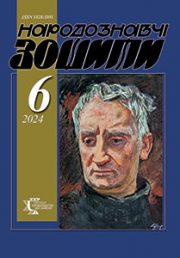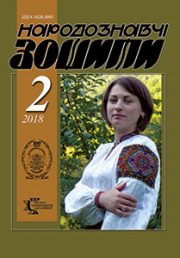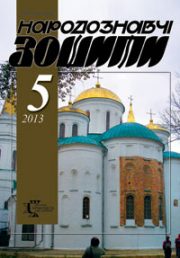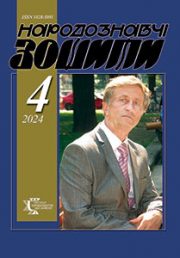The Ethnology Notebooks. 2019, № 3 (147), 563—579
UDK 738:39:7.046.1 (4)
DOI https://doi.org/10.15407/nz2019.03.563
POTTERY IN THE IVAN FRANKO’S FOLKLORE RESEARH HERITAGE
RAKHNO Kostyantyn
ORCID ID: https://orcid.org/0000-0002-0973-3919
Doctor of Sciences in History, Leading Researcher
of the Natioanal Museum of Ukrainian Pottery in Opishne,
102 Partyzanska Street, 38164 Opishne,
Zinkiv District, Poltava Region, Ukraine
Contacts: е-mail: krakhno@ukr.net
Abstract. Ivan Franko (1856—1916), an outstanding writer, a classic of Ukrainian literature and an equally outstanding scholar, made a remarkable contribution to various fields of Ukrainian culture, including folklore studies and ethnography. His scientific heritage, studying of which is very relevant today, contains a number of published works, which featured pottery, one of the most ancient crafts of the Ukrainians. Like other ancient crafts, it was consecrated with mythology, surrounded by rites and customs and generously reflected in Ukrainian folklore. The goal of the author is to explore it. The object of the research is Ivan Franko’s folklore records, consisting of fairy tales, mythological legends, kolomyikas and other songs, sayings and proverbs, descriptions of popular beliefs and superstitions, folk medicine and charms, wedding and calendar rituals. The subject is ideas presented in them which describe the various aspects of pottery-making, the role and functions of clay and earthenware in the traditional way of life of the Ukrainians of the Boyko Region, Hutsul Region, and Pokuttya in the late 19th — early 20th centuries. The methodological basis of this research is the historical and geographical method in combination with principles and methods of historiographical studies.
The basis of the work is etiological legends, recorded by Ivan Franko. They reveal the mythological significance of pottery raw material — clay, fairy tales, proverbs, and sayings show the attitude of the people to the profession of a clay carrier, potter, pottery trader, earthenware repairer. The creation of people and animals, in particular wolves, from clay, has been described in the legends. The creators were God and devil, as usual in the Ukrainian dualistic beliefs. One of the fairy tales, recorded by Ivan Franko from his mother, reveals a story about the King Thrushbeard, where the main heroine was forced to trade pots. It was very popular in Europe. Other Ukrainian versions of this fairy tales were recorded by Volodymyr Hnatiuk, a friend of Ivan Franko. The results of the paper are that these Ivan Franko’s folklore materials throw light on the process of pottery making from clay mining and producing ceramic ware to its sale, as well as the variety of earthenware — such as a pot, pitcher, jar, poppy basin, bowl, clay necklace — and their use. The usage of crockery, including the preparation of traditional Ukrainian dishes, was shown accurately and particularly in numerous proverbs and sayings. Kolomyika songs, which Ivan Franko loved very much, were another valuable source. Different semiotic and symbolic aspects of pottery were revealed in the family and calendar customs, rituals, as well as in the therapeutic magic practice of healers and witch doctors. This magic practice could include the ritual of black magic with the use of clay figurine. Viewing the Ivan Franko’s published works shows the importance of studying his folklore-ethnological heritage from new perspectives.
Keywords: pottery, folklore, fairy tales, legends, wedding ceremonies, folk medicine, sayings, proverbs, songs, Ivan Franko.
Received 12.04.2019
REFERENCES
Vincenz, St. (1997). On the High Uplands (The Truth of the Primeval Times). Lviv: Chervona Kalyna [in Ukrainian].
Hnatiuk, V. (1909). Hayivka Songs. In Materials for the Ukrainian Ruthenian Ethnology. (Vol. XII, pp. 1—100). Lviv: Printing House of the Taras Shevchenko Scientific Society [in Ukrainian].
Hnatiuk, V. (1897). Ethnographic Materials from Hungarian Rus. Volume I. Legends and Short Stories. In Ethnographic Compendium (Vol. ІІІ). Lviv: Printing house of the Taras Shevchenko Scientific Society [in Ukrainian].
Hnatiuk, V. (1909). Ethnographic materials from Hungarian Rus. Volume IV. Tales, Legends, Short Stories, Historical Remembrances from Banat. In Ethnographic Compendium (Vol. XXV). Lviv: Printing House of the Taras Shevchenko Scientific Society [in Ukrainian].
Hnatiuk, V. (1905). Kolomyika Songs. Vol. I. In Ethnographic Compendium. (Vol. XVIІ). Lviv: Printing House of the Taras Shevchenko Scientific Society [in Ukrainian].
Hnatiuk, V. (1906). Kolomyika Songs. Vol. II. In Ethnographic Compendium (Vol. XVIІI). Lviv: Printing House of the Taras Shevchenko Scientific Society [in Ukrainian].
Hnatiuk, V. (1907). Kolomyika Songs. Tom III. In Ethnographic Compendium (Vol. XIХ). Lviv: Printing House of the Taras Shevchenko Scientific Society [in Ukrainian].
Hnatiuk, V. (1919). Human Figurines Made of Wax. In Proceedings of the Taras Shevchenko Scientific Society (Vol. CXVIII, pp. 212—216). Lviv: Printing House of the Taras Shevchenko Scientific Society.
Drahomanov, M. (2008). Folklore Studies: in 4 vol. (Vol. 4). Donetsk: Nord-Press [in Ukrainian].
Zinoviyiv, K. (1971). Poems. Sayings of the Common People. Kyiv: Naukova Dumka [in Ukrainian].
Kolessa, I. (1901). Galician Ruthenian Folk Songs with Melodies, Gathered in the Village of Khodovychi, by Dr. Ivan Kolessa. In Ethnographic Compendium (Vol. XI). Lviv: Printing House of the Taras Shevchenko Scientific Society [in Ukrainian].
Kolessa, F. (2005). History of Ukrainian Ethnography. Kyiv: M.T. Rylsky Institute of Art Studies, Folklore Studies and Ethnology. NAS of Ukraine [in Ukrainian].
Kolomyika Songs in the Ivan Franko’s Records. Systematization of texts, preface, and notes by O.I. Dey. (1970). Kyiv: Muzychna Ukrayina [in Ukrainian].
Folk Songs in the Ivan Franko’s Records. Systematization of texts, introduction, and notes by O.I. Dey. (1981). Kyiv: Muzychna Ukrayina [in Ukrainian].
Songs of the Native Village: Ukrainian Folk Songs. Folk recordings and arrangement by А.А. Put. Foreword and Review by M.M. Gordiychuk (1987). Kyiv: Muzychna Ukrayina [in Ukrainian].
Rybskiy, Feofan. (1895). Wedding Rites and Songs in the Village of Makiv of the Kamyanets District of the Podillya Government. In Living Antiquities. St. Petersburg, II, 222—234 [in Russian].
Franko, I. (1883). Ancient Roman-Germanic Short Story in the Mouths of the Ruthenian people. In Star. Lviv, 2, 27—30 [in Ukrainian].
Franko, I. (1894). From the Mouths of the People. In Life and Word: the Bulletin of Literature, History, and Folklore (Volume II, pp. 179—198). Lviv: Printing House of the Stauropegial Institute under the management by I. Pukhyr [in Ukrainian].
Franko, I. (1901). Galician Ruthenian Folk Proverbs. Collected, arranged, and explained by Dr. Ivan Franko. Issue 1 (A — To Know). In Ethnographic Compendium (Vol. X). Lviv: Printing House of the Taras Shevchenko Scientific Society [in Ukrainian].
Franko, I. (1901—1905). Galician Ruthenian Folk Proverbs. Collected, arranged, and explained by Dr. Ivan Franko. Issue 2 (To Know — Children). In Ethnographic Compendium (Vol. XVI.) Lviv: Printing House of the Taras Shevchenko Scientific Society [in Ukrainian].
Franko, I. (1907). Galician Ruthenian Folk Proverbs. Collected, arranged, and explained by Dr. Ivan Franko. Volume II, issue I (Children — To Jeer). In Ethnographic Compendium (Vol. XХІІI). Lviv: Printing House of the Taras Shevchenko Scientific Society [in Ukrainian].
Franko, I. (1908). Galician Ruthenian Folk Proverbs. Collected, arranged, and explained by Dr. Ivan Franko. Volume II, issue II (Tailor — Five). In Ethnographic Compendium (Vol. XXIV). Lviv: Printing House of the Taras Shevchenko Scientific Society [in Ukrainian].
Franko, I. (1909). Galician Ruthenian Folk Proverbs. Collected, arranged, and explained by Dr. Ivan Franko. Volume III, issue I (Plunder — Time). In Ethnographic Compendium (Vol. XVIІ). Lviv: Printing House of the Taras Shevchenko Scientific Society [in Ukrainian].
Franko, I. (1910). Galician Ruthenian Folk Proverbs. Collected, arranged, and explained by Dr. Ivan Franko. Volume third (Plunder — Barley). In Ethnographic Compendium (Vol. XXVIII). Lviv: Printing House of the Taras Shevchenko Scientific Society [in Ukrainian].
Franko, I. (1898). Hutsul Spells. In Ethnographic Compendium (Vol. V, pp. 41—72). Lviv: Printing House of the Taras Shevchenko Scientific Society [in Ukrainian].
Franko, I. (2008). Additional Volumes to the Collected Works in Fifty Volumes (Vol. 53). Kyiv: Naukova Dumka [in Ukrainian].
Franko, I. (1898). Folk Beliefs on the Foothill, collected by Dr. Ivan Franko. In Ethnographic Compendium (Vol. V, pp. 160—218). Lviv: Printing House of the Taras Shevchenko Scientific Society [in Ukrainian].
Franko, I. (1898). Five Legends. In Ethnographic Compendium (Vol. V, pp. 111—116). Lviv: Printing House of the Taras Shevchenko Scientific Society [in Ukrainian].
Shukhevych, V. (1908). Hutsul Region. The 5th part. Lviv: The Common Printing House [in Ukrainian].
Bolte, J., & Polivka, G. (1913). Notes on the Children’ and Household Tales of the Grimm Brothers (Vol. 1—60)). Leipzig: Dieterich’sche Verlagsbuchhandlung Theodor Weicher [in German].
Philippson, E. (1923). The Fairytale Type of King Thrushbeard. Greifswald: Suomalainen Tiedeakatemia Academia Scientiarum Fennica [in German].
Franko, I. (1886). Wedding Ceremonies and Songs of the Ruthenian People in the Village of Lolyn in the Stryj District, Collected by Olha Roshkevych, Edited by Ivan Franko. In The Compendium of Reports on Regional Anthropology (Vol. X, pp. 1—54). Krakуw: Printing House of the Jagiellonian University [in Polish].
Franko, I. (1884). Remnants of the Primeval Worldview in Ruthenian and Polish Folk Riddles. In Weekly Review of Social Life, Literature and Fine Arts. Monthly supplement, 6, 103—119 [in Polish].







